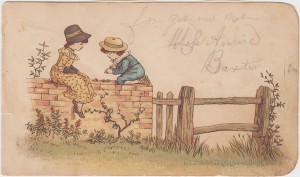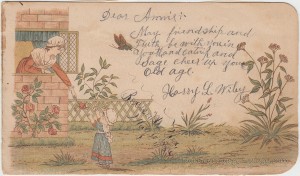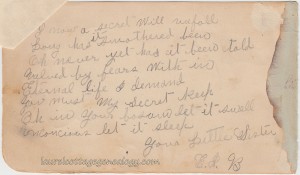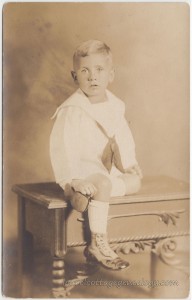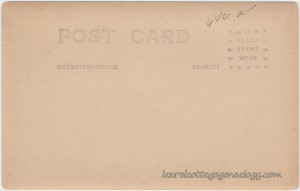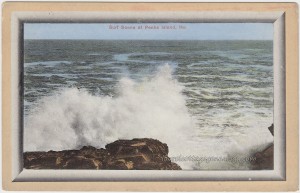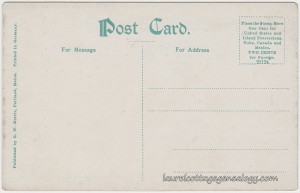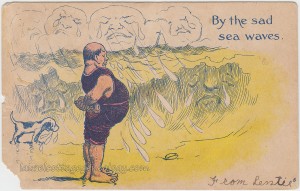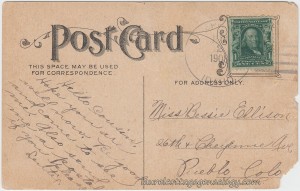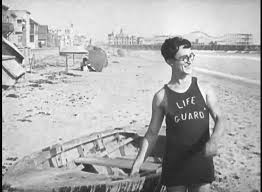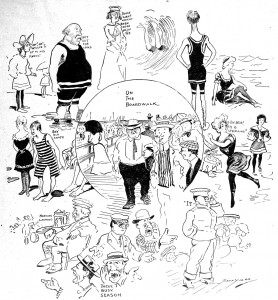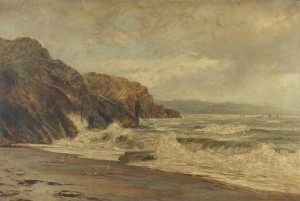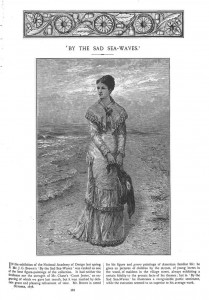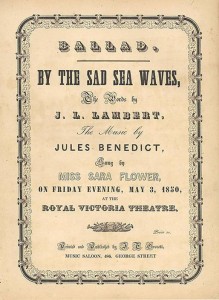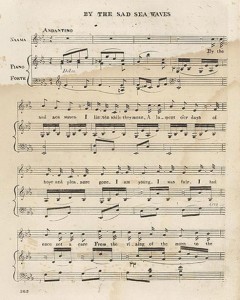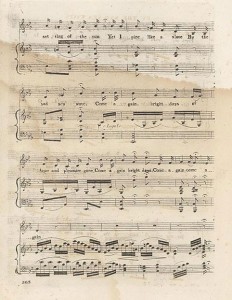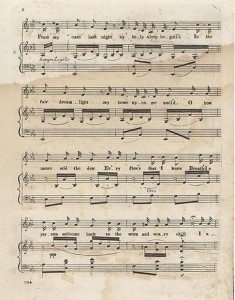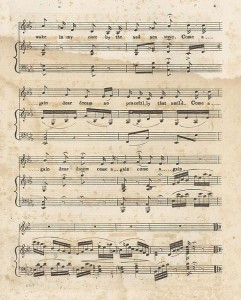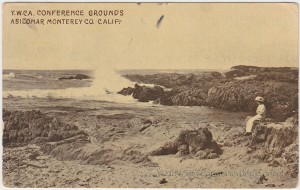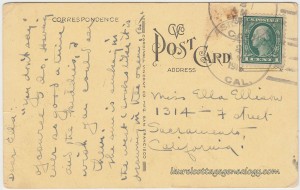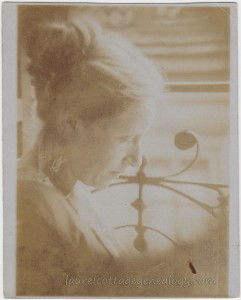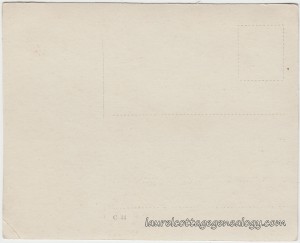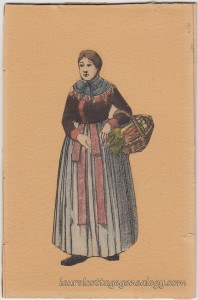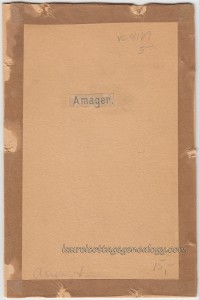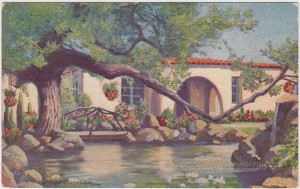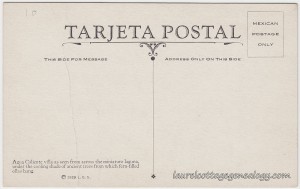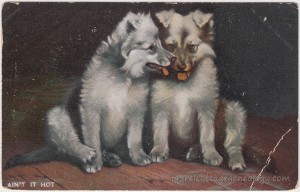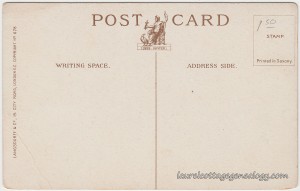John Paul Burnham (1882 or 1883 – 1956)
See Agua Caliente Villa for our postcard by the artist.
According to the very helpful website AskArt, which we’ve accessed before for research, “John Paul Burnham was born in Illinois on August 14, 1883. John Paul was the son of architect Franklin Burnham, and a resident of Los Angeles by 1900. By 1910 he had a home in South Pasadena and was a magazine illustrator. He worked there as an artist until his death on Feb. 8, 1956.
Census records show that John Paul’s mother’s first name was Adelia. From this we find the marriage record showing that Franklin P. Burnham married Adelia S. Milliken on January 29, 1877 in Cook County, Illinois. Franklin was about age 23, and Adelia about age 20.
The 1880 Federal Census taken in Chicago shows the young family, including one year-old daughter, Jenni, living with head of household Paul, (John Paul’s grandfather) and Paul’s daughter Mary Orcutt, (Franklin’s sister) her husband, William Orcutt, and their daughter, May. John’s father, Franklin Pierce Burnham, became a well-known architect, and is listed on this census record under that occupation.
The 1900 Federal Census, taken in Los Angeles, shows Franklin, Adelia, Jennie and John Paul, age 17, dealer in bicycles.
By 1908, at about age 25, John was listed as having joined the staff of The Art Students League of Los Angeles, teaching illustration and composition.
The following clip from the Los Angeles Evening Express, October 14, 1909, indicates Burnham had a studio in New York City. He and fellow artist, Joseph D. Gleason, along with the crew and the rest of the passengers, had a close call in the Bermudas when their steamer, Antilles, went aground. “Angeleno” means being from Los Angeles:
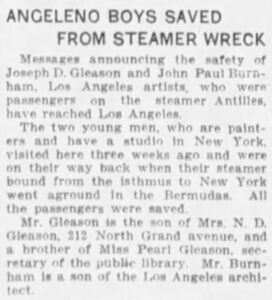
The 1910 Federal Census for Pasadena, California shows he is living with his mother (widowed) and his unmarried aunt, Grace Milliken. At this time, he is working as an artist for a magazine.
By 1918, Burnham had gone back to the East Coast. His WWI Draft Registration card shows he was living in New York City and working as an art manager and artist at the ad agency Ruthrauff & Ryan. (On this record he gives his year of birth as 1882, rather than the 1883 stated above which shows up officially under the California Death Index.)
The Dartnell Advertising Agency Guide, compiled in 1924, shows J. P. Burnham with the above-mentioned, Ruthrauff & Ryan, now working as head of the art department.
Presumably, Burnham would have moved from NYC back to California sometime from 1924 through 1930 when he shows up listed as John Burnham on the 1930 Federal Census for Pasadena; occupation artist, and listed as a “guest” at the grand and exclusive Hotel Huntington. (Estimated date of birth on this record is 1887 but we know this is John because the AskArt website shows a Burnham painting of the Huntington.)
Below, a 1930 airplane passenger list showing John Paul traveling from Agua Caliente, Mexico to California. By chance, there are two other Burnhams on this record, husband and wife Frederic and Adda, but as far as we know, there was no relation:
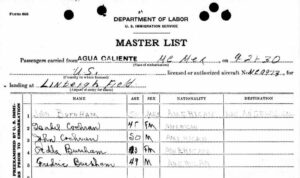
The Smoketree School
Continuing on with our research, it seems that John Paul may have been best known for being a member of the “Smoketree School” of artists. According to a magazine article by author, Ann Japenga, John Paul Burnham was one of 27 artists who lived and painted in the Coachella Valley, California area. Burnham’s address was 147 S. Tahquitz Dr., Palm Springs, circa late 1920s.
When Japenga started writing about the desert artists of the early 1900s, she coined the phrase for their genre as being of the “Smoketree School” in the way that the Hudson River, New York area artists became known under that geographical heading, or that art critics refer to the “Eucalyptus School” because of the Eucalyptus tree being a popular subject for the California coast artists. (The smoke tree or bush is part of the native California desert vegetation, and has various shades of “smoky” pink flowers that bloom from June through August, with the leaves changing color to shades of orange, red and purple in autumn.) John Paul Burnham, according to one of two Japenga articles, was better known as a patron to the local artists. Among others in the desert art community were Agnes Pelton, R. Brownell McGrew, John Hilton, Axel Linus. See the prior post on our Laurel Cottage site for a beautiful example (albeit from a postcard) of Burnham’s work that he did in Tijuana, Mexico.
The 1940 Federal Census shows him living in Los Angeles, occupation artist and painting teacher.
_____________________________________________________________________
Sources: “John Paul Burnham.” AskArt. Web accessed 21 Aug 2014 [http://www.askart.com/AskART/B/john_paul_burnham/john_paul_burnham.aspx]
“Illinois, Cook County Marriages, 1871-1920,” index, FamilySearch (https://familysearch.org/pal:/MM9.1.1/N7XC-G4S : accessed 23 Aug 2014), Franklin P. Burnham and Adelia S. Milliken, 29 Jan 1877; citing Cook, Illinois, , Cook County Courthouse, Chicago; FHL microfilm 1030100.
Franklin Pierce Burnham. n.d. http://en.wikipedia.org/wiki/Franklin_Pierce_Burnham. (accessed August 23, 2014)..
Year: 1900; Census Place: Los Angeles Ward 5, Los Angeles, California; Roll: 89; Page: 5B; Enumeration District: 0050; FHL microfilm: 1240089. (Ancestry.com)
“A Seed of Moderism: The Art Students League of Los Angeles, 1906 – 1953.” Traditional Fine Arts Organization. Feb. 29, 2008. Web accessed 22 Aug 2014 [http://www.tfaoi.com/aa/8aa/8aa6.htm]
“Angeleno Boys Saved From Steamer Wreck.” Los Angeles Evening Express, October 14, 1909. Thursday, p. 18. (Newspapers.com).
Year: 1910; Census Place: South Pasadena, Los Angeles, California; Roll: T624_87; Page: 2B; Enumeration District: 0347; FHL microfilm: 1374100. (Ancestry.com)
Registration State: New York; Registration County: New York; Roll: 1765791; Draft Board: 105. (Ancestry.com).
Ruthrauff & Ryan. n.d. https://en.wikipedia.org/wiki/Ruthrauff_%26_Ryan (accessed February 2, 2024).
The Dartnell Advertising Agency Guide, 1925 Edition. (1924) New York: The Dartnell Corporation. (Google.com book search).
Passenger Lists, 1929-1954, and Crew Lists, 1941-1954, of Airplanes Arriving at San Diego, California. Microfilm Publication A3472, 10 rolls. NAID: 3950379. Records of the Immigration and Naturalization Service, Record Group 85. The National Archives in Washington, D.C.
Japenga, Ann. “Where Artists Thrived” Palm Springs Life. Web accessed 22 Aug 2014. [http://www.palmspringslife.com/Palm-Springs-Life/Art-Culture/Winter-Spring-2013/Where-Artists-Thrived/]
Ann Japenga. PBS SoCal. https://www.pbssocal.org/people/ann-japenga (accessed February 2, 2024).
Brown, Renee, “History: Early artists captured beauty of valley desert.” The Desert Sun. July 17, 2014. Web accessed 21 Aug 2014. [http://www.desertsun.com/story/life/entertainment/arts/2014/07/17/palm-springs-history-desert-artists/12819525/]
Japenga, Ann. “The Smoketree School: Painters Respond to the Call of the Desert.” Palm Springs Life. Web accessed 24 Aug 2014 [http://www.palmspringslife.com/Palm-Springs-Life/Art-Culture/Winter-Spring-2011/The-Smoketree-School/]
Year: 1930; Census Place: Pasadena, Los Angeles, California; Roll: 169; Page: 16B; Enumeration District: 1250; Image: 396.0; FHL microfilm: 2339904. (Ancestry.com).
Coachella Valley. n.d. https://en.wikipedia.org/wiki/Coachella_Valley (accessed February 2, 2024).
“United States Census, 1940,” index and images, FamilySearch (https://familysearch.org/pal:/MM9.1.1/K9CV-8JN : accessed 24 Aug 2014), John P Burnham, Councilmanic District 5, Los Angeles, Los Angeles Township, Los Angeles, California, United States; citing enumeration district (ED) 60-326, sheet 61B, family 557, NARA digital publication of T627, roll 402.

